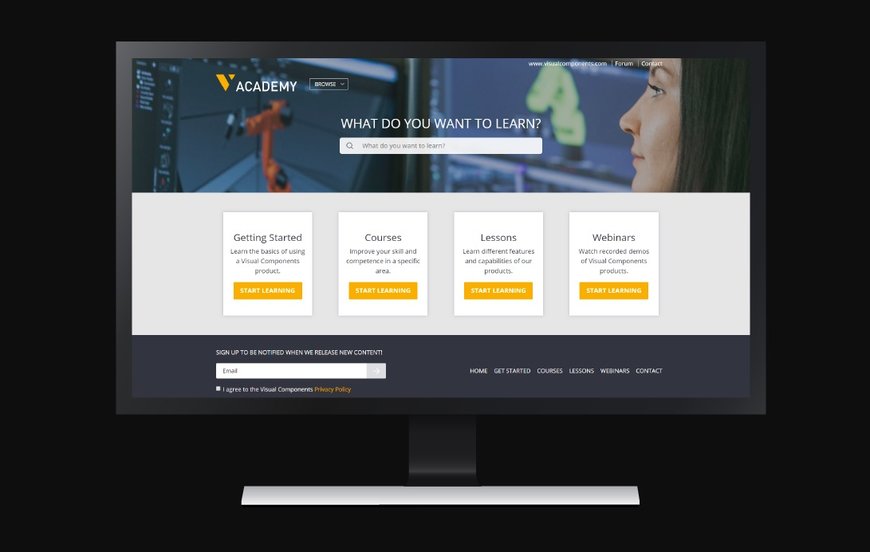www.industryemea.com
28
'20
Written on Modified on
Visual Components Academy: 10 Free Courses To Take While You’re #wfh
With many of us working from home, it’s a great opportunity to focus on developing professional skills in 3D manufacturing simulation. With 12 courses and 180+ lessons and growing, the Visual Components Academy contains a wealth of free educational content for users at all skill levels. In this blog post, we’ll highlight some courses for you to improve your skills and proficiency in Visual Components.

For busy professionals, one of the toughest things to make time for is their own development; something else always seems to come up. With many of us now #WFH (working from home), it’s a great opportunity to re-focus on developing those professional skills. With 12 courses and 180+ lessons and growing, the Visual Components Academy contains a wealth of educational content for users at all skill levels. And, it’s all available for free! In this blog post, we’ll highlight some courses for you to explore to improve your skills and proficiency in Visual Components.
Check out the Getting Started course for a quick and general overview of Visual Components. You’ll learn the basics of navigation, selection, and visualization in the 3D world as well as how to configure a layout. You’ll get a brief introduction to Process Modeling and the Works Library as well as the basics of robot teaching and mobile robots. The course wraps up with a lesson on how to access the Help tab and additional online resources that are available.
If you’re new to Visual Components or recently updated your license to version 4.2.0 or later, a great course to check out is What’s New in 4.2. You’ll get an introduction to some of the key new features and improvements in 4.2, including Process Modeling, Interactive VR, new supported export formats, and more. Process Modeling is a major new feature set we introduced in 4.2, with lots of functionality and applications. If you want to dive deeper into Process Modeling, take the Introduction to Process Modeling course and explore the many Process Modeling lessons available in the Academy.
Component modeling is a powerful and expansive feature set available in Visual Components Professional and Premium products. If you want to learn how to turn your CAD data into intelligent, simulation-ready components, check out the Basics of Component Modeling course. You’ll learn how to model equipment such as robots, end-effectors, and positioners, and become familiar with some of the built-in tools Visual Components has to streamline the modeling process.
Speaking of robots, we have several courses available to help you become more proficient with robots in Visual Components. Basics of Robot Programming provides a quick introduction for beginners on how to manually create statements to define the actions and logic of a robot program. For more advanced users, check out the Python Robotics course to learn how to read and write robot programs as well as control robots using Python scripts. If you’re not familiar with the Python API, make sure to first take the Basics of Python Scripting course to learn the basics of the Python API in Visual Components.
For mobile robots enthusiasts, the course Simulate Mobile Robots provides an in-depth introduction into how you can configure layouts to use different types of mobile robots, plan and implement their routes and tasks, and troubleshoot common issues associated with the vehicles. If you want to learn how to model mobile robots with Visual Components, the course Model a Mobile Robot will teach you how to model a mobile robot and define its logic using the Python API.
We’re constantly creating new lessons and courses to help our users become more proficient with Visual Components and we welcome your feedback on what we can do to improve. If you have any Academy related questions or feedback or suggestions for new tutorials, please join the discussion in the Visual Components Forum. We’d love to hear from you.
www.visualcomponents.com

